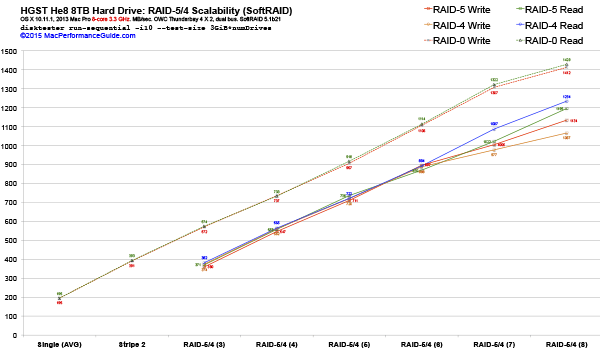
$220 SAVE $130 = 37.0% Western Digital 16.0TB Western Digital Ultrastar DC HC550 3.5-in… in Storage: Hard Drives
|

|

|

|

|

|

|

|

|

|
HGST Ultrastar He8 Performance: RAID-0 vs RAID-4 / RAID-5 Compared 3/4/5/6/7/8 Drives
Related: hard drive, HGST, Other World Computing, RAID, RAID-0, RAID-4, RAID-5, storage
Get HGST 8TB Ultrastar He8 Hard Drive at OWC.
Also utilized in the 32TB OWC Thunderbay 4 RAID-5 edition.
RAID-4 and RAID-5 are “striping with parity”.
A RAID-5 uses the equivalent of one drive capacity of N drives for parity information. It can be thought of as a RAID-0 stripe with one parity drive (“striping with parity”), for fault tolerance. RAID-5 uses distributed parity and RAID-4 uses a dedicated parity drive; functionality is equivalent, so the only question is whether one performs better than the other for any particular (specific) implementation.
Ideally, performance should scale linearly with the number of drives. Also, a 3-drive RAID-5 / RAID-4 should perform reasonably close to a 2-drive RAID-0 stripe.
Performance testing by DiskTester, part of diglloydTools.
Drives hosted in the OWC Thunderbay 4 with software RAID by SoftRAID 5.1b21.
RAID-4 vs RAID-5 vs RAID-0 sustained transfer speed
DiskTester run-sequential used to test peak speed of empty volume, freshly erased. Throughput figures are real-world figures through the OS X file system.
This is excellent: the RAID-4 and RAID-5 configurations with three drives are nearly as fast as a 2-drive RAID-0 stripe. That’s all one can hope for. However, the performance lags that of an equivalent RAID-0 stripe in general; the 5-drive RAID-4 still is not as fast as a 4-drive RAID-0 stripe. If maximum performance is required, striping is still the best option. As well, software RAID-4/RAID-5 with 4 or 5 drives does consume the better part of one CPU core, so it is not “free” in CPU terms.
Note that at least with up to 7 drives, RAID-4/5 are about as fast as a RAID-0 stripe with one less drive—excellent.
RAID-4 outperforms RAID-5 for reads using 4 or 5 drives, and is slightly less fast for writes. RAID-4 thus seems to be the better choice. However, the advantage is scarcely larger than the margin of test error (normal variation between iterations).

Seagate 22TB IronWolf Pro 7200 rpm SATA III 3.5" Internal NAS HDD (CMR)
SAVE $100

 diglloydTools™
diglloydTools™

